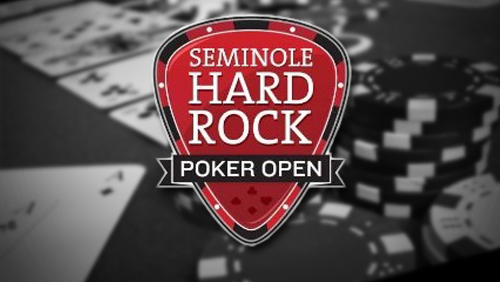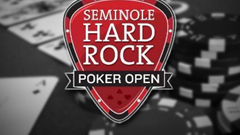 Going into this month’s inaugural Seminole Hard Rock Poker Open (SHRPO) at the Seminole Hard Rock Hotel & Casino in Hollywood, Florida, the poker world’s focus was squarely on the $5,300 Championship Event and its $10,000,000 guaranteed prize pool. At twice the money that had ever been guaranteed for a poker tournament, it was a target without any kind of precedent. Would the Hard Rock be able to draw at least 2,000 players, many of them from out of state? Would it come up short of its goal but within sight of the guarantee? Or would there be a big overlay, putting casinos around the U.S. off big guarantees for the foreseeable future?
Going into this month’s inaugural Seminole Hard Rock Poker Open (SHRPO) at the Seminole Hard Rock Hotel & Casino in Hollywood, Florida, the poker world’s focus was squarely on the $5,300 Championship Event and its $10,000,000 guaranteed prize pool. At twice the money that had ever been guaranteed for a poker tournament, it was a target without any kind of precedent. Would the Hard Rock be able to draw at least 2,000 players, many of them from out of state? Would it come up short of its goal but within sight of the guarantee? Or would there be a big overlay, putting casinos around the U.S. off big guarantees for the foreseeable future?
As it turned out the big event brought 2,384 players to the Hard Rock’s tables, building a total prize pool of $11,920,000. Past WSOP bracelet winner Blair Hinkle took down the $1.74 million prize, a sum that would have been considered smallish at the peak of the poker boom but is pretty damned good money these days – and that’s before accounting for the fact that it was a $5K tournament. The tournament was a huge success, signaling the arrival of Florida as a major worldwide poker tournament market. It also confirmed that two and a half years after losing online poker, live tournament poker is alive and well in the United States. And it showed that there’s still room in the market for new tournament festivals, particularly when they give players great value for their money.
Florida Arrives
Poker has been legal in Florida for years, but for most of its history there have been absurdly low limits on the stakes that kept the state off the map as a place for playing a serious game. Since the state legislature lifted those restrictions in 2010, the market has developed rapidly and attracted established tournament circuits like the World Poker Tour and the World Series of Poker Circuit. But the Seminole Hard Rock Poker Open is the state’s first major homegrown success story.
With 19.3 million people as of 2012, Florida is the second most populous state with legal poker in the entire country, trailing only California. It’s fitting, then, that the very first installment of its new marquee event would resemble some of the long-running tournament festivals out west in terms of participation in the bigger tournaments on the schedule. Event #1 (a $350 No Limit Hold’em tournament), Event $6 ($125 NLHE), and Event #7 ($560 NLHE) each drew more than 3,000 players. And like the biggest events in California, the SHRPO Championship Event showed that it’s not just the locals coming out to play. The field of nearly 2,400 was a Who’s Who of the stars of poker, featuring Poker Hall of Famers, past world champions, and even a handful of celebrities.
The arrival of Florida is a big deal for poker. It’s a large market with no immediate regional competition, giving it plenty of near-future upside. It has all sorts of tourist appeal beyond what’s going on at the poker tables, with all its beaches, golf courses, and nightlife giving it a leg up on a lot of the more traditional big poker markets when it comes to attracting players from outside the area. And it’s a lot closer than the West Coast for players in Europe who might want to consider hopping a flight to play for the world’s largest guaranteed prize pool.
Big Guarantees
The success of the $10 million guarantee is big news right now. Like any other record, it’s likely to inspire some dreaming among those in a position to pull off the same feat. Poker is an industry that loves its trends, and players could be in for a treat if anybody else can pull off a similar big guarantee.
It’s doubtful we’ll see any more guarantees of quite the same size in America too soon, since there aren’t too many potential tournament locations with the same combination of a large local population and the infrastructure for handling plenty of out-of-town guests. More established events like the L.A. Poker Classic might be able to pull off a similar feat, but it’s hard to imagine many others being able to do the same. With new markets opening up in other populous states like Pennsylvania and Ohio, and even in smaller states like Maryland (which went live this week with lines around the block to get in and play), the success of the SHRPO could provide a template that could be replicated on a smaller scale. Perhaps they could start with a smaller buy-in and a proportional guarantee, like the $1,000,000 guarantee for the $560 buy-in Event #7. Anything that could help jump-start the market in those areas, where there’s plenty of competition from nearby states, will probably be on the table.
Overseas could be a different matter, though. Europe could conceivably pull off a similarly sized field, particularly if it some sort of agreement could be reached between potential competitors not to step on each others’ toes with scheduling. Australia is probably still a bit short of being able to bring together 2,000 players for a $5,000 buy-in, and Asia is many years away from that sort of a wealthy player base. But both those Pacific markets have a track record of drawing decent fields for High Roller and Super High Roller events. A $10,000,000 guarantee in a $100,000 tournament would be fathomable in either Macau or Melbourne.
Probably the most interesting question on this topic is how big the Championship Event guarantee will be at next year’s SHRPO. Shooting for $10 million was a gamble this year, one that paid off handsomely. So how big will the Seminole management go next year – $12 million? $15 million? What they decide will say a lot about how confident the rest of us should be in Florida’s future as a poker market.
Value Welcome
There’s nothing poker players like more than getting good value. The SHRPO schedule and structures serve as a modern-day model for giving players what they want, starting with the variety of the schedule. Eight of the 33 events were in non-hold’em games, and the 25 hold’em tournaments featured a variety of formats including turbo and ante-only structures, bounties, and deep-stack events. The value extended to the range of buy-ins, where there really was something for players of nearly every conceivable bankroll. Some tournaments featured buy-ins as a low as $125, three had buy=ins between $1,100 and $2,200, and there was even a Super High Roller event with a $100,000 price tag.
Fans of skill poker had to love Matt Savage’s structure for the Championship Event, which had the players stacked deep throughout the tournament and led to a six-and-a-half-hour heads-up match between Justin Bonomo and eventual champion Blair Hinkle. It was an even match between the two pros as both were able to maintain an aggressive posture without ever having to resort to all-in-or-fold poker, a far cry from the old day of TV poker, where even the chip leader was short-stacked when the big money was on the line.
There’s more competition in the market today than ever before, giving players who don’t feel like they’re getting their money’s worth plenty of other options. That means that other properties who want to replicate SHRPO’s success in the future will have to do more than just promise big guarantees – they’ll have to provide similar value, which is a win for poker players everywhere.
